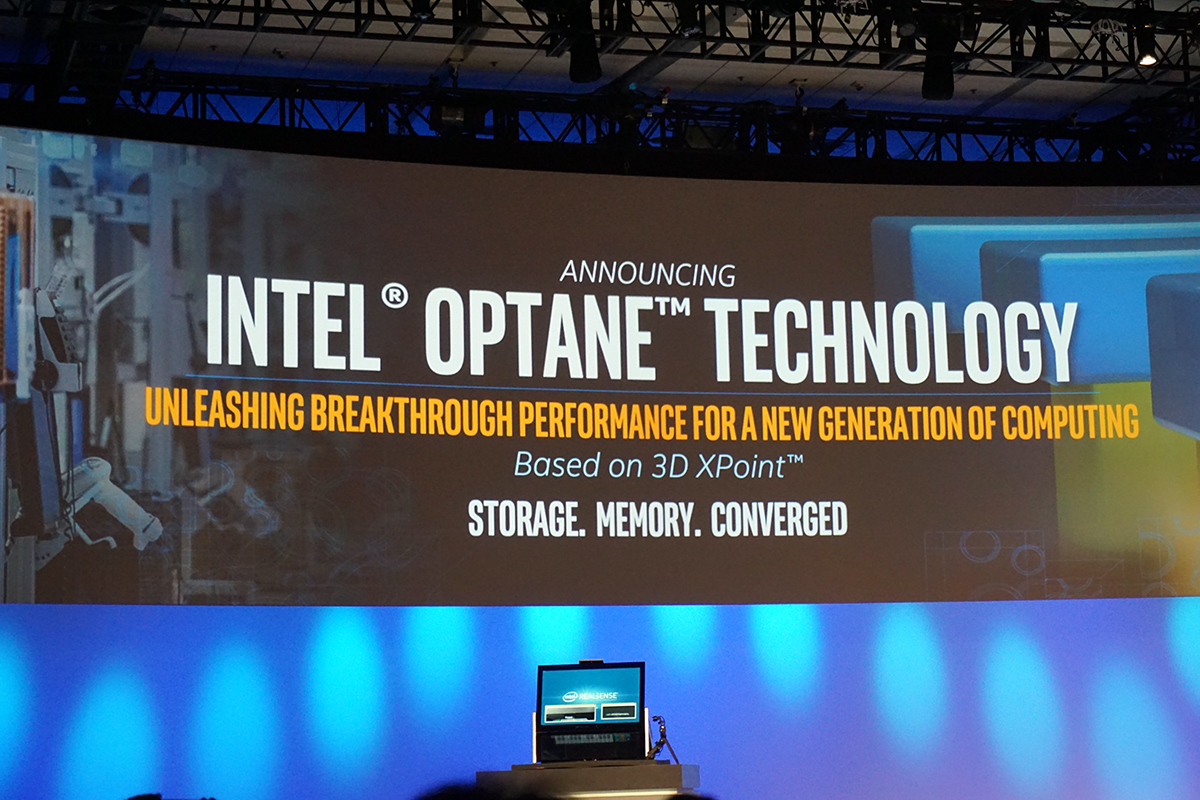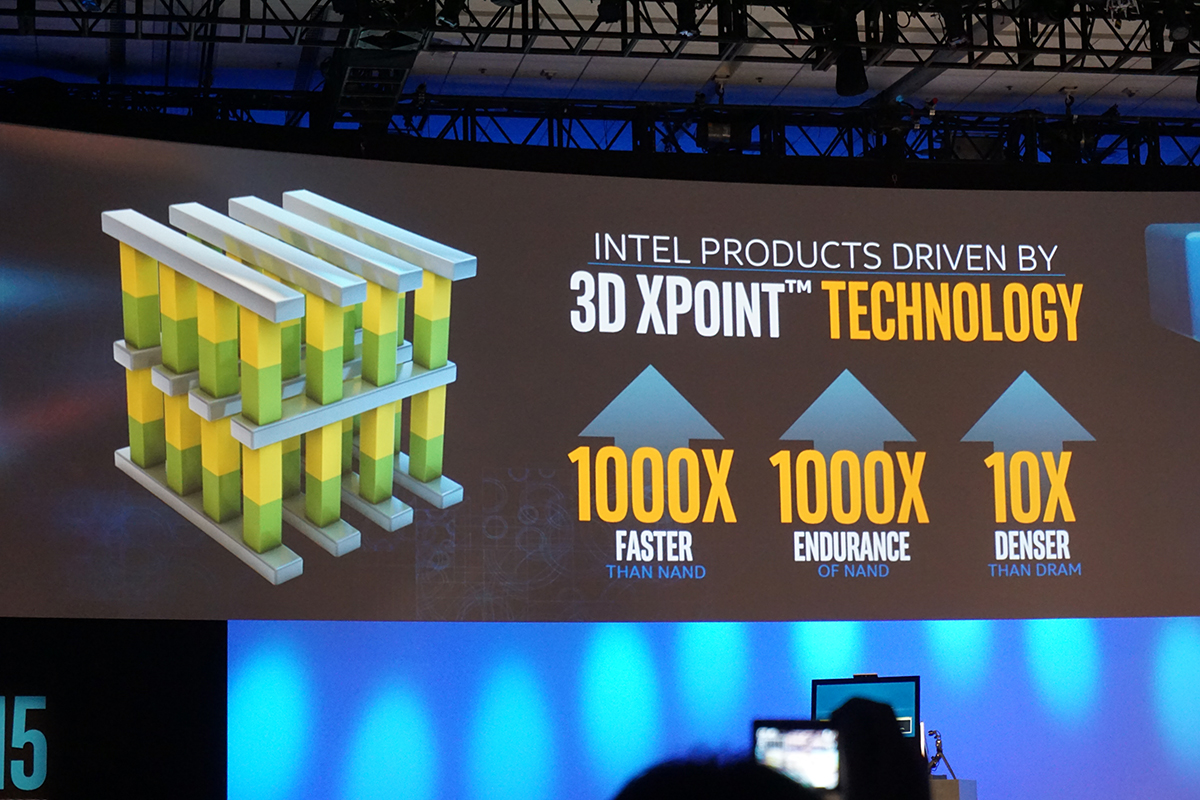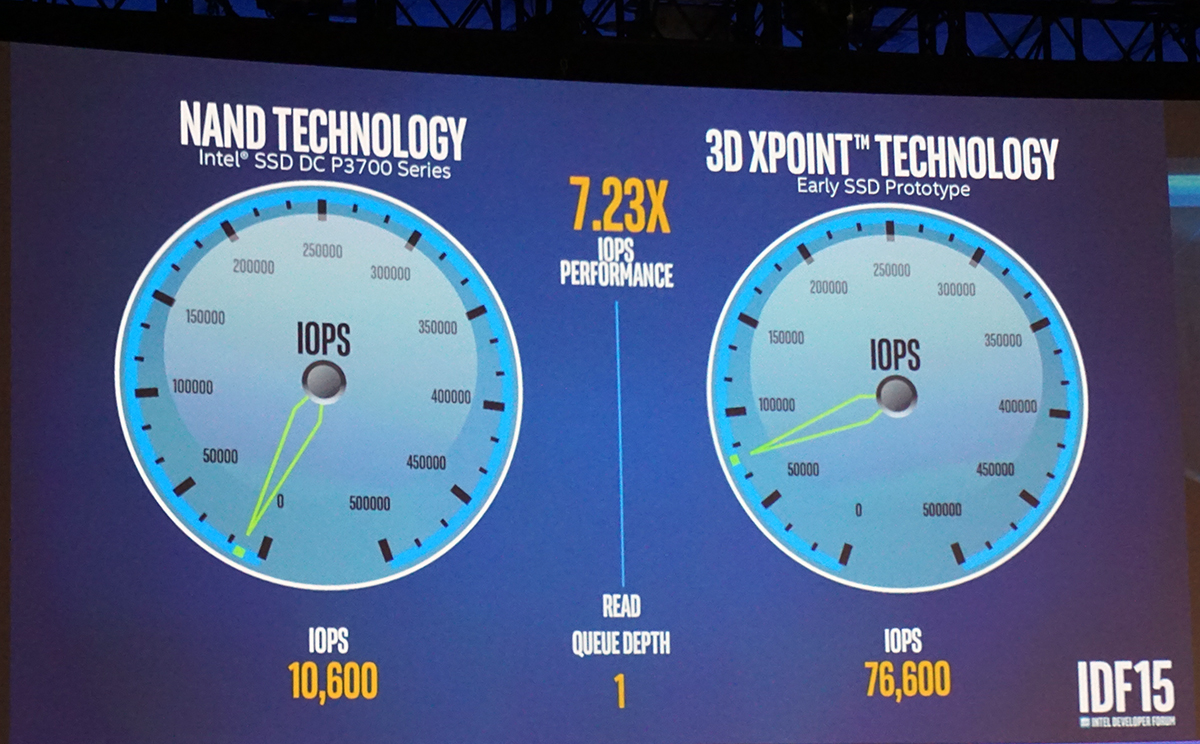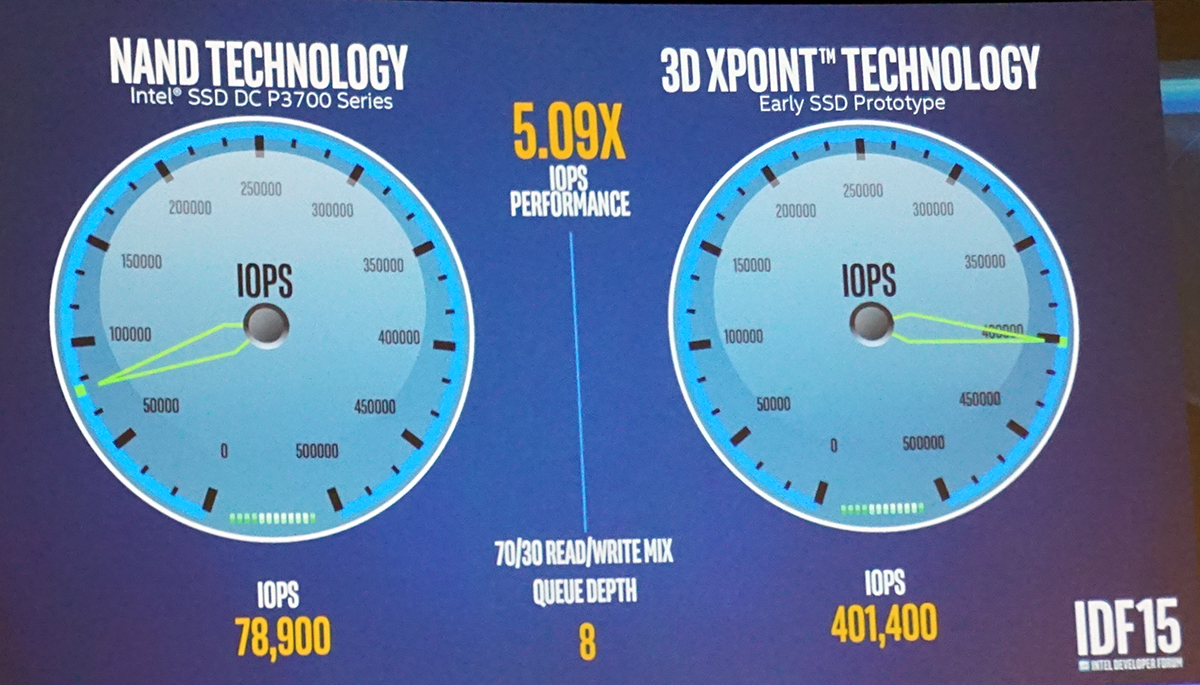Intel-Micron's 3D Xpoint Technology Branding Announced, Launching 2016
From the IDF 2015 stage, Intel CEO Brian Krzanich briefly touched on the revolutionary 3D Xpoint technology co-developed by Intel and Micron. The memory/storage combination tech, which promises extraordinary performance leaps over existing NAND technology, will launch in 2016 under the brand "Intel Optane Technology."
We could have guessed on the timeline, but BK (as he is affectionately called) also stated that Xpoint will be coming across all manner of platforms, from the data center all the way down to ultrabooks.
This is a big deal because it means that the paradigm of fast, low-capacity memory placed next to the CPU paired with slow, high-capacity storage connected to the motherboards, may not be long for this world. (BK called this a "bottleneck.") To say that such an implementation would rock the PC industry is an understatement.
We've already written a lengthy announcement about 3D Xpoint, so for a full primer visit our article here, but the bite-sized takeaway of the new tech's capabilities boil down to:
-1000x faster than NAND-1000x the endurance of NAND-10x the density of DRAM
Xpoint -- er, Intel Optane Technology -- will be available in both DIMM and SSD form factors. The DIMMs will be for Xeon system memory, presaging its use as an in-memory solution for applications like big data.
Intel's non-volatile memory GM, Rob Crooke, described in general terms how 3D Xpoint will work, but stopped short of discussing the actual technology behind the bulk material property change. Many analysts have predicted PCM, or phase-change memory, but Intel has flatly denied that. There is also speculation around ReRAM. We still hope to hear more here at IDF.
Get Tom's Hardware's best news and in-depth reviews, straight to your inbox.
Onstage Benchmarking
Intel set up an onstage demo showing an early Xpoint SSD in action. Using the IOMeter benchmark, it showed a 7.23x (and sometimes more) performance gain over Intel's SSD DC P3700 at a read queue depth of 1 -- the SSD hit 10,600 IOPS while the early Xpoint SSD prototype delivered 76,600 IOPS.
At a 70/30 read/write mix at a queue depth of 8, the prototype Xpoint SSD posted a 5.09x (and sometimes higher) performance gain over the P3700 (401,400 IOPS versus 78,900 IOPS.)
The Intel SSD DC P3700 is Intel's bleeding edge NVMe PCIe SSD for the data center, and has incredible endurance. In other words, as a comparison point, Intel didn't pick a crippled baseline here.
A QD of 1 might seem an odd metric to highlight, but it is tremendously important in client/desktop-like applications. Today's NAND-based SSDs have long been at a point of diminishing returns in this area.
Application Benefits
Intel sees Xpoint technology as a way to deliver huge benefits in areas such as enhanced rich media, immersive gaming, mass-scale cloud computing, HPC and more, delivering new experiences in areas including big data analytics, personal healthcare and so on.
The company is clearly excited about Xpoint (Intel Optane). And it should be.
Seth Colaner is the News Director at Tom's Hardware. Follow him on Twitter @SethColaner. Follow us @tomshardware, on Facebook and on Google+.
Seth Colaner previously served as News Director at Tom's Hardware. He covered technology news, focusing on keyboards, virtual reality, and wearables.
-
gangrel :: passes over the roll of paper towels::Reply
I still kinda think that endurance is going to be an issue in terms of replacing RAM, as the amount of writes to main memory is high. Perhaps not; we'll see. But for anything less directly connected...wow. Major combination of endurance and capacity; speed's almost a bonus. Price will be the issue, but hopefully, with very high capacity, it might not be that bad. -
RobrtV Reply::I still kinda think that endurance is going to be an issue in terms of replacing RAM, as the amount of writes to main memory is high.
Am I wrong in thinking that combining non-volatile storage and traditional RAM into one solution will eliminate the need for writes back and forth? If its already on the same device, you just read... no extra writes that you would traditionally see calling data into RAM -
gangrel For static data, but that's essentially the same as program code, you're potentially correct. Putting a system into standby/hibernate might require nothing; same with starting back up. The RAM is already loaded. Obviously, this is going to require special handling, but it does offer that potential.Reply
But you might see systems with, say, 16 GB of this stuff, with a larger, cheaper storage. Then you'll need to load the 'RAM' for a new program. -
dkaplan73 It's also worth noting that saving and CTRL-S would effectively be dead. Essentially RAM and storage would be one and the same. Everything is read/written in real time. No need to save.Reply -
Daniel Ladishew This seems the perfect solution for SoC and embedded hardware. It would mean one less component for those solutions.Reply
I have also long wondered when we would start to see mobos with integrated storage for OS installation, and this seems like it would fit that use case pretty well also. Imagine if your OS never had to touch a traditional storage device for all it's normal operations. We could see a second drastic increase in latency and performance of the OS similar to the adoption of SSDs. -
gangrel dkaplan: No. A save is a copy of the dynamic state...a snapshot. It's deliberately kept separate from the actual game/document/whatever, so changes *aren't* reflected. Also, it's still likely that Xpoint used as 'RAM' will be comparatively limited in size, at least for the time being. 'RAM' is read/written cell by cell. That gets to be more difficult as you increase size. You'll still generally see the model that programs have to get swapped in and out. This wouldn't have to be the case on more dedicated systems, tho.Reply -
wardwing so if I am understanding this right, Xpoint is combining DRAM (Storage) and RAM (Memory) into one solution. Essentially creating a SSD/RAM hybrid? how is that any different from existing NVRAM?Reply
this sounds like they are making what basically amounts to a really fast ram disk -
CaptnKirk Replyso if I am understanding this right, Xpoint is combining DRAM (Storage) and RAM (Memory) into one solution. Essentially creating a SSD/RAM hybrid? how is that any different from existing NVRAM?
this sounds like they are making what basically amounts to a really fast ram disk
Well, yes, if you consider a 6tb drive that operates as memory too and runs at near DDR 4 speed as just a really fast ram drive...
My brother helped develop this and I knew nothing about it until the press release and even then he couldn't say a lot, but said it is most definitely a game changer.
There will be some interim solutions to implement it until an appropriate interface can be developed to really use it. Intel says they will have a module that is pin and electrically compatible with a DDR 4 socket available, but the CPU will have to have some different control systems integrated to use it that way. So expect a new type of CPU to use it, but they claim they will put out a Xeon that useless it with the ability to put 6tb in memory slots. The database possibilities are unfathomable. -
gangrel When I was doing a bit of review on relative speeds, I ran across an applicable point. Beyond speed, the other major difference between RAM and SSD is address mode. RAM is organized to read/write individual words; SSDs read/write blocks, usually 256 bytes these days. AMD64 allows 48 bits for virtual memory addressing, according to wiki; that still gives you 256 tb of directly addressable space. That's bloody huge. :) But it could be slower...if that matters. It might not.Reply
But yes...database servers. In another sense we can have the return of Big Iron...take an 18-core Xeon, create maybe 14 VMs, each using a core by itself, and each with 30 gb of RAM. The other 5 tb are allocated as a 'disk' once a controller can handle this kind of split. The scientific computing possibilities are also crazy.




